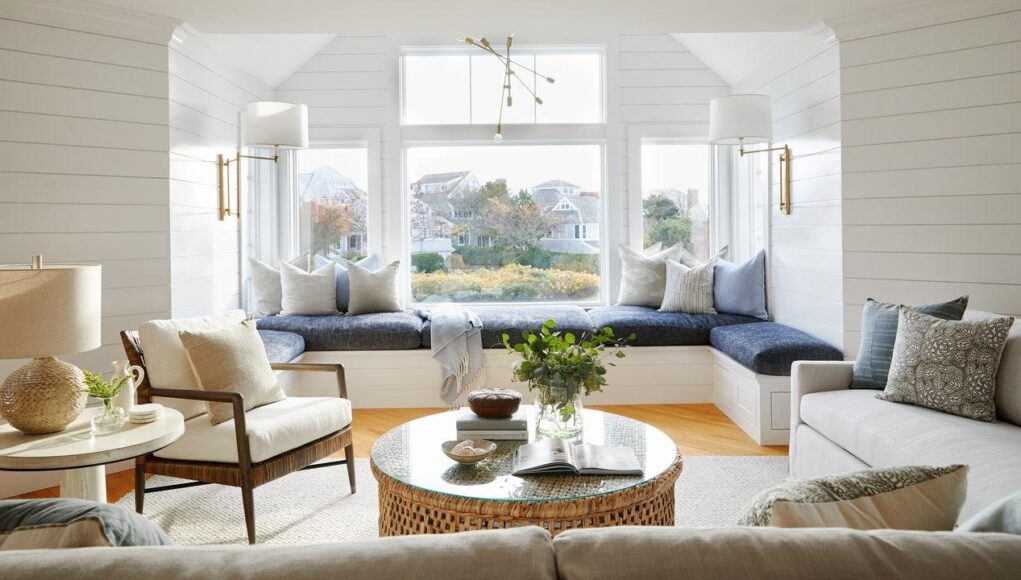Drawing inspiration from the sand, sea, and sky, coastal interior design helps you bring the tranquility of the beach into your home. After all there are few things in the world that conjure peace quite like the sound of waves crashing on the shore. “Coastal interior design is a sophisticated design perspective that should evoke a sense of easy, luxuriously understated living,” says Sarah Solis, a Malibu-based interior designer, founder and principal of Sarah Solis Design Studio, and member of the AD Pro directory. “Coastal interiors have soft tones with relaxed and comfortable materials executed with strong lines and intention without feeling too loose or undefined.” To learn more about this serene style, AD spoke with Solis and Angela Hamwey, a Massachusetts-based interior designer and founder of Mackenzie & Co. Dive into the peaceful look below.
What is coastal interior design?
Clear from the name, coastal interior design is a style inspired and influenced by the coast. “Coastal interior design is rooted in drawing inspiration from the scenic landscape to bring the natural beauty of the surroundings in,” says Hamwey. “The design is influenced by the rich coastal tones of the deep blue ocean, honeyed-colored boat hulls, and textures reminiscent of dune grass.” Hamwey also explains that the key to a coastal style largely lies in the colors, which should blend seamlessly from the outdoors into the interiors. “Earth tones and natural textures must work together to create a design that is harmonious with its surroundings,” she says.
In coastal interiors, you’ll often find royal or navy blues and crisp whites along with plenty of natural elements and textures such as wood, linen, jute, and rattan. “Natural materials like wood beams and flooring, washed linens, cashmere, alpaca, and lots of plaster walls are a must to define this look and create an authentic feeling,” adds Solis. “Architecturally speaking, large-scale windows expanding on the exterior landscape that allow for indoor-outdoor living are at the heart of this style. The windows capture the essence, and the relaxed materiality defines the vibe.”
Consider the differences between the rocky coastline of a New England beach and a tropical beach in Florida with turquoise blue water. Though they’re both sea and shore, it’s easy to understand both the aesthetic and atmospheric difference between the two. The same goes for coastal and beachy design. “While both coastal and beachy designs take cues from natural seaside elements through the use of neutral colors and natural textures in the home, there are factors that differentiate the two,” says Hamwey.
Generally speaking, coastal design is more nautical, and leans into darker elements and touches that feel reminiscent of a captain’s quarters. “This is achieved through the thoughtful layering of dark wood tones, the incorporation of vintage or patinated pieces, and a color palette that reflects the deep, rich tones of coastal waters and the cragginess of the shoreline,” explains Hamwey. Beachy interiors, on the other hand, are breezier, lighter, and less precise. “A beachy design is rooted in creating a serene aesthetic through the use of breezy linens, light wood tones, and a muted color palette to inherently translate feelings of relaxation,” says Hamwey. In a beach house you’ll see more natural oak tones, relaxed linen textiles, and accents of Aegean blue compared to a coastal home.
Using these different design elements, naturally, creates a different effect from each home. “Coastal design tends to be more tailored, traditional, and refined, whereas a beachy look feels more like relaxed fit jeans,” adds Solis. A coastal space often makes use of clean lines and definition of shape in furnishings, whereas beachy homes are more laid back. “Both easy living,” says Solis. “Just different perspectives of what that means and how it is executed.”
History of coastal interior design
Coastal interiors have been around for quite some time and are not often considered a new design trend. “Coastal design has a long-standing history originally stemming from the means in which people decorated their lavish waterfront or seaside homes in areas such as the Hamptons,” explains Hamwey. “Through various approaches, coastal design now reflects an individual’s interpretation of how they draw inspiration to bring the natural beauty of the surrounding elements into the home.”
As Solis adds, modern coastal design as we know it today has been architecturally driven through an emphasis on large scale windows that expand the view and bring the outdoor landscape into the home. “The style has traditionally framed the landscape as part of the art within the home,” she explains. “Sophisticated materiality choices that beautifully complement and don’t compete with the view, alongside thoughtful architectural details that elevate the relaxed experience are all key tenets of this tradition.”
Some people will also use “coastal” as a catch-all term for any interior design style that draws inspiration from or is connected to the beach such as beachy, nautical, Mediterranean, or tropical. However, coastal is still understood as its own distinct aesthetic too.
Defining elements and characteristics of coastal interior design
To better understand the coastal look, consider the elements that go into crafting the aesthetic. “Coastal interiors often focus on a soft, washed, or faded neutral toned color palette paired with natural materials and soft touch experiences such as washed linen, cashmere, wool, and alpaca,” explains Solis. Though not exhaustive, coastal interiors often make use of the following design motifs:
- Large windows with an emphasis on natural light and framing landscapes
- White walls
- Color scheme that draws inspiration from a rocky beach, including blue, white, cream, green, and gray
- Clean lines
- Construction materials that include natural wood elements throughout, and matte painted surfaces or plaster finishes
- Woven and natural textures such as rattan and jute
- Classic design elements such as sisal rugs, slip-covered furniture, linen, and ticking stripe patterns
Examples of coastal interior design
For some design ideas that channel the coastal vibe, consider these projects from Hamwey and Solis.
How to bring coastal interior design into your home
If your home design could benefit from a touch-up and the coastal aesthetic feels like a fit, Solis and Hamwey have design tips to help you create the look.
According to Hamwey, it’s best to avoid kitschy or expected decor when creating a coastal interior. “Instead of incorporating elements like shells, starfish, and navy blue stripes, take inspiration from the natural environment for everything from the color palette through to the materials used,” she advises. She recommends leaning into earth tones, natural textures, and thoughtfully layered blues. “This aesthetic is meant to evoke the feelings of relaxation and ease that waterside living brings to everyday life,” she adds.
Solis recommends looking for sophisticated materials in soft, comfortable tones and fabrics. As she explains, this helps establish the tailored and polished feelings that’s important when creating the coastal look. “Think creatively about ways you can blend indoor and outdoor living with understated elements that complement the landscape and create a lighter and airier interior,” she says. “Luxurious natural materials, clean lines, and classic architectural elements will all help to ground the space in a timeless coastal look.”
Both Solis and Hamwey agree that not only is coastal design not out of style, it likely never will be. “Coastal interiors are 100% in style because they are 100% timeless,” says Solis. “The color palettes are so beautifully tonal and restful; it’s a forever cool style.” However, as Hamwey explains, considering whether a style is “in” isn’t often the most helpful approach when considering your interiors. “It’s about creating a timeless aesthetic that is authentic to the many ways you use and enjoy your home,” she explains. “Design is not limiting in that you must follow a certain aesthetic. It’s a means of expression and storytelling.”
Nonetheless, coastal interiors continue to be a popular style that many gravitate towards, especially in areas near the sea that want to honor that natural beauty on the inside of their homes. “By taking cues from the natural environment, coastal interiors reflect the natural beauty of the surroundings to encourage ultimate relaxation,” says Hamwey. “Coastal interiors combine classic elements to create a design that is truly timeless.”








